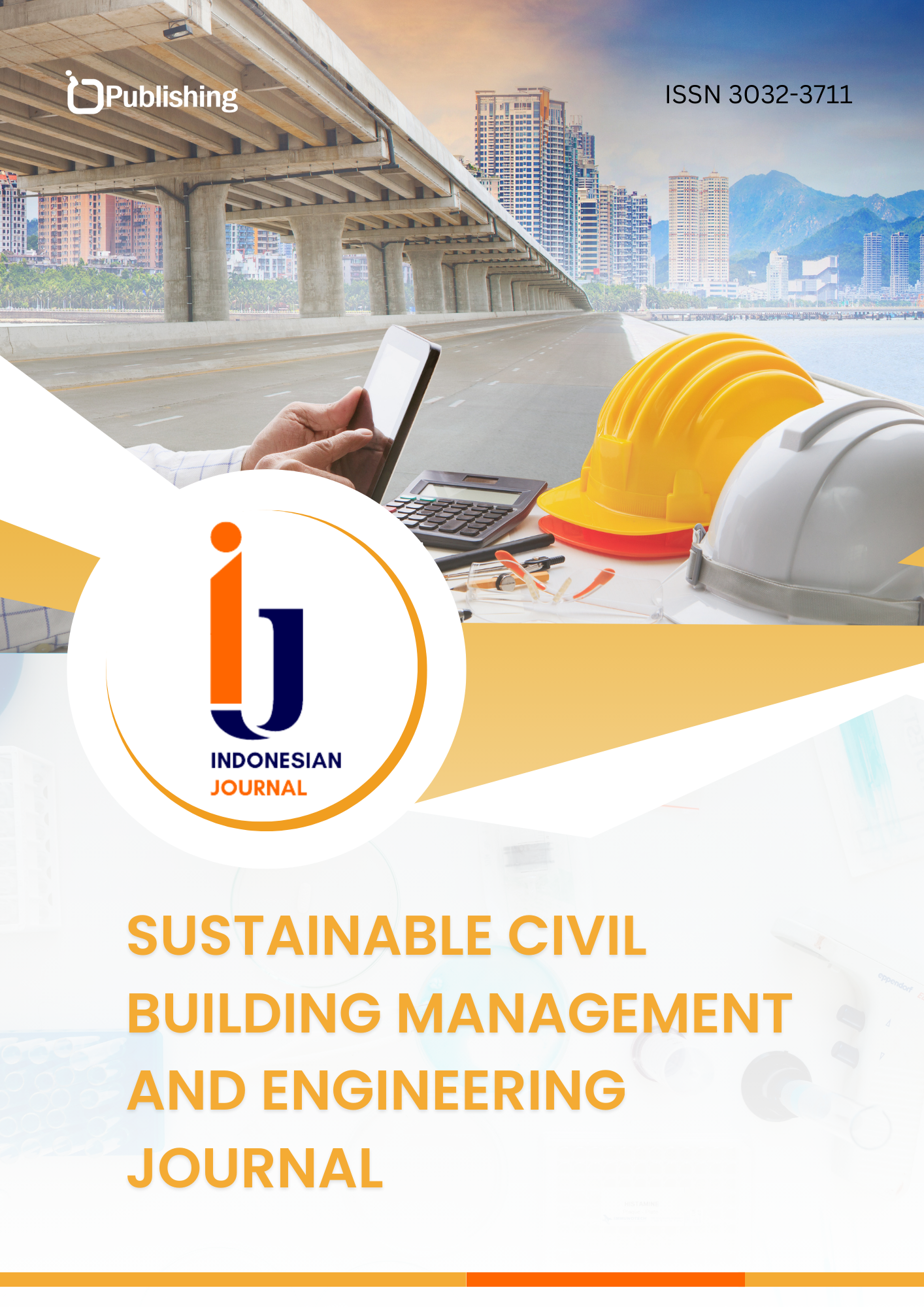Features of the Design of Residential Buildings
DOI:
https://doi.org/10.47134/scbmej.v1i2.2352Keywords:
Residential Buildings, Architectural and Planning Solutions, Apartment Buildings, 4-5-Storey Buildings, Geographical Environment, Bukhara Houses, Houses Built in the Ferghana and Khiva StyleAbstract
The article discusses each type of residential and public buildings has its own spatial planning solution, the design of which reflects a rather complex workflow. When designing multi-family residential buildings, economic factors are primarily taken into account. In particular, the construction of residential buildings in Uzbekistan has its own historical tradition. The houses were built in two versions -national and European. These houses mainly consist of houses with separate courtyards. This study employs a qualitative research approach, drawing insights from architectural literature and historical records to examine the design features of residential buildings in Uzbekistan. Data collection involves literature review, analysis of architectural plans, and examination of historical documents. The analysis reveals that the design of multi-family residential buildings is influenced by various factors, including economic considerations, cultural heritage, and historical traditions. In Uzbekistan, the architectural landscape reflects a blend of national and European styles, each with its own spatial planning solutions and design elements. Traditional houses with separate courtyards not only provide privacy and security but also contribute to the overall aesthetics of residential neighborhoods. Additionally, economic factors play a significant role in shaping the design process, with cost-effective construction methods and materials being prioritized in residential building projects.
References
Abdiyev, H. J. (2022). The Importance Of Furniture In The Interior Of Preschool Institutions. British Journal Of Global Ecology And Sustainable Development, 5, 94–96. Https://Journalzone.Org/Index.Php/Bjgesd/Article/View/73
Abdiyev, H. J., & Tashmatova, X. S. (2022). Maktabgacha Ta’lim Tashkiloti Binosining Interyerida Mebelni Loyihalashning Zamonaviy Usullari. Arxitektura Dizayni Jurnali, 7, 4–7. Https://Geniusjournals.Org/Index.Php/Jad/Article/View/1666
Abdujabbarova, M. T. (2018). Design Of Residential Buildings:Tutorial 284. Taqi.
Bertoldi, P. (2021). How To Finance Energy Renovation Of Residential Buildings: Review Of Current And Emerging Financing Instruments In The Eu. Wiley Interdisciplinary Reviews: Energy And Environment, 10(1). Https://Doi.Org/10.1002/Wene.384 DOI: https://doi.org/10.1002/wene.384
Dolce, M. (2021). Seismic Risk Assessment Of Residential Buildings In Italy. Bulletin Of Earthquake Engineering, 19(8), 2999–3032. Https://Doi.Org/10.1007/S10518-020-01009-5 DOI: https://doi.org/10.1007/s10518-020-01009-5
Huo, T. (2021). Dynamic Scenario Simulations Of Carbon Emission Peak In China’s City-Scale Urban Residential Building Sector Through 2050. Energy Policy, 159. Https://Doi.Org/10.1016/J.Enpol.2021.112612 DOI: https://doi.org/10.1016/j.enpol.2021.112612
Huo, T. (2021). Nonlinear Influence Of Urbanization On China’s Urban Residential Building Carbon Emissions: New Evidence From Panel Threshold Model. Science Of The Total Environment, 772. Https://Doi.Org/10.1016/J.Scitotenv.2021.145058 DOI: https://doi.org/10.1016/j.scitotenv.2021.145058
Huo, T. (2022). Carbon Emissions In China’s Urban Residential Building Sector Through 2060: A Dynamic Scenario Simulation. Energy, 254. Https://Doi.Org/10.1016/J.Energy.2022.124395 DOI: https://doi.org/10.1016/j.energy.2022.124395
Imran. (2022). Iot Task Management Mechanism Based On Predictive Optimization For Efficient Energy Consumption In Smart Residential Buildings. Energy And Buildings, 257. Https://Doi.Org/10.1016/J.Enbuild.2021.111762 DOI: https://doi.org/10.1016/j.enbuild.2021.111762
Kadirova, S. A., & Abdujabbarova, M. T. (2019). Proektirovanie Jilix I Obtshestvennix Zdani: Uchebnoe Posobie. Organization.
Krarti, M. (2021). Review Analysis Of Covid-19 Impact On Electricity Demand For Residential Buildings. Renewable And Sustainable Energy Reviews, 143. Https://Doi.Org/10.1016/J.Rser.2021.110888 DOI: https://doi.org/10.1016/j.rser.2021.110888
Li, H. (2021). Energy Flexibility Of Residential Buildings: A Systematic Review Of Characterization And Quantification Methods And Applications. Advances In Applied Energy, 3. Https://Doi.Org/10.1016/J.Adapen.2021.100054 DOI: https://doi.org/10.1016/j.adapen.2021.100054
Mannan, M. (2021). Indoor Air Quality In Buildings: A Comprehensive Review On The Factors Influencing Air Pollution In Residential And Commercial Structure. International Journal Of Environmental Research And Public Health, 18(6), 1–24. Https://Doi.Org/10.3390/Ijerph18063276 DOI: https://doi.org/10.3390/ijerph18063276
Obaydullaev, X. M., & Inagamova, M. M. (2005). Tipologicheskie Osnovi Proektirovaniya Jilix I Obtshestvennix Zdani: Uchebnoe Posobie. Preemnik-Izd-Vo.
Olu-Ajayi, R. (2022). Building Energy Consumption Prediction For Residential Buildings Using Deep Learning And Other Machine Learning Techniques. Journal Of Building Engineering, 45. Https://Doi.Org/10.1016/J.Jobe.2021.103406 DOI: https://doi.org/10.1016/j.jobe.2021.103406
Pauliuk, S. (2021). Global Scenarios Of Resource And Emission Savings From Material Efficiency In Residential Buildings And Cars. Nature Communications, 12(1). Https://Doi.Org/10.1038/S41467-021-25300-4 DOI: https://doi.org/10.1038/s41467-021-25300-4
Rosti, A. (2021). Empirical Fragility Curves For Italian Residential Rc Buildings. Bulletin Of Earthquake Engineering, 19(8), 3165–3183. Https://Doi.Org/10.1007/S10518-020-00971-4 DOI: https://doi.org/10.1007/s10518-020-00971-4
Sidikovna, T. X., & Erkinovna, K. M. (2023). Metody Proektirovaniya Detskix Doshkolnyx Organizatsiy V Gorodskix I Selskix Rayonax. Central Asian Journal Of Sanat Va Dizayn, 4(3), 49–52. Https://Doi.Org/10.17605/Osf.Io/Jxdch
Sidykovna, T. K. (2023). Methods Of Designing Preschool Organizations In Urban And Rural Areas. Nexus: Journal Of Advances Studies Of Engineering Science, 2(6), 56–59. Https://Innosci.Org/Jises/Article/View/1456
Wang, P. (2022). An Integrated Technical, Economic, And Environmental Framework For Evaluating The Rooftop Photovoltaic Potential Of Old Residential Buildings. Journal Of Environmental Management, 317. Https://Doi.Org/10.1016/J.Jenvman.2022.115296 DOI: https://doi.org/10.1016/j.jenvman.2022.115296
Wei, W. (2021). Residential Net-Zero Energy Buildings: Review And Perspective. Renewable And Sustainable Energy Reviews, 142. Https://Doi.Org/10.1016/J.Rser.2021.110859 DOI: https://doi.org/10.1016/j.rser.2021.110859
Xu, Y. (2022). Prediction And Optimization Of Heating And Cooling Loads In A Residential Building Based On Multi-Layer Perceptron Neural Network And Different Optimization Algorithms. Energy, 240. Https://Doi.Org/10.1016/J.Energy.2021.122692 DOI: https://doi.org/10.1016/j.energy.2021.122692
Yan, R. (2022). Decarbonizing Residential Buildings In The Developing World: Historical Cases From China. Science Of The Total Environment, 847. Https://Doi.Org/10.1016/J.Scitotenv.2022.157679 DOI: https://doi.org/10.1016/j.scitotenv.2022.157679
Yuldasheva, M. K., & Kamilova, M. (2023). Foreign Experience In The Design And Construction Of Innovative Architecture Of Museums Of The World. Central Asian Journal Of Arts And Design, 320–326.
Zhong, X. (2021). Global Greenhouse Gas Emissions From Residential And Commercial Building Materials And Mitigation Strategies To 2060. Nature Communications, 12(1). Https://Doi.Org/10.1038/S41467-021-26212-Z DOI: https://doi.org/10.1038/s41467-021-26212-z
Downloads
Published
How to Cite
Issue
Section
License
Copyright (c) 2024 Khudayberdiyev Keldiyar, Tashmatova Khosiyat

This work is licensed under a Creative Commons Attribution 4.0 International License.










